
ラブラドライトの宝石:特性、意味、価値など
 ラブラドライトは、アデュラレッセンスの一種である「ラブラドレッセンス」と呼ばれる、内部に美しい虹彩を見せる長石宝石です。この特徴は「 シラー」と呼ばれることもあります。
ラブラドライトは、アデュラレッセンスの一種である「ラブラドレッセンス」と呼ばれる、内部に美しい虹彩を見せる長石宝石です。この特徴は「 シラー」と呼ばれることもあります。
犬好きの皆さん、申し訳ありませんが、ラブラドライトは犬種にちなんで名付けられたわけではありません。カナダのラブラドール州にちなんで名付けられました。実際、ラブラドライトはラブラドール州とその州であるニューファンドランド島の公式鉱物です。
「フェルスパー」という名前は、アマゾナイト、オーソクレース、サンストーン、ムーンストーンといった同族の宝石からも見覚えがあるかもしれません。多くのサンストーンは実際にはラブラドライトに分類されます。その一例がオレゴンサンストーンで、アベンチュレッセンスと呼ばれる金属的な輝きを放ちます。ラブラドライトは、オーソクレースに次いでファセットカットされたフェルスパーの中で最もよく見られる宝石です。
オレゴンサンストーン以外にも、ラブラドライトにはいくつかのサブタイプがあります。今日は、それらの種類に加え、ラブラドライトの特性、ヒーリング効果、象徴性など、ラブラドライトの宝石に関するあらゆる疑問についてご紹介します。
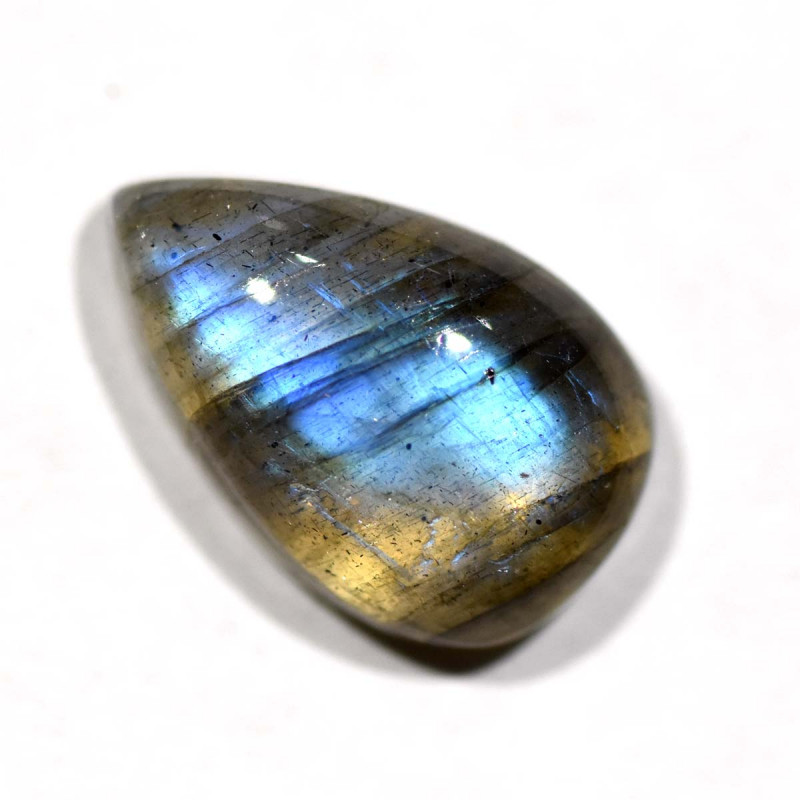
ラブラドライト石について
まず、ラブラドライトは貴石でしょうか?いいえ、ラブラドライトは半貴石です。「貴石」とみなされる宝石は、ダイヤモンド、サファイア、ルビー、エメラルドだけです。しかし、ラブラドライトは幸運のお守りとなることもあります!
ラブラドライトはどんな誕生石ですか?ラブラドライトは11月の誕生石の1つで、土曜日生まれの人にとっては素晴らしい誕生石です。
占星術的に、ラブラドライトの星座石は蟹座を彩り、ラブラドライトの変種であるスペクトロライトは蠍座、射手座、獅子座に幸運をもたらします。ラブラドライトの惑星は天王星または冥王星ですが、金星の重要な時期にラブラドライトを身につけることを推奨する占星術師もいます。
鉱物の特性
ラブラドライトは、ナトリウム、カルシウム、アルミニウム、ケイ素からなる灰長石(アノーサイト)の斜長石鉱物です。ナトリウム含有量は30~50%、カルシウム含有量は50~70%です。この石は灰長石とアルバイト長石から構成されていますが、その組成は灰長石が50~70%、アルバイトが30~50%です。
長石鉱物群は複雑ですが、最も一般的な2つのカテゴリーは斜長石とアルカリ長石です。斜長石の中で、ラブラドライトは強いシラー効果を示す唯一の鉱物です。
モース硬度計では、ラブラドライトは6から6.5の硬度を持ちます。ラブラドライトは一般的に白、灰色、黄色、または無色ですが、その真価を発揮するのはラブラドレッセンスです。文字通り、虹色のあらゆる色彩がラブラドライト内部から輝きを放ちますが、最も一般的なのは青とオレンジです。
重要な注意点:すべてのラブラドライトがラブラドレッセンスを示すわけではありません。光学的な効果が全く見られないものもあれば、青みがかった白色のアベンチュレッセンスのみが見られるものもあります。
種類といえば、ラブラドライトのサブタイプを見ていきましょう。
 上の写真:スペクトロライト
上の写真:スペクトロライト
ラブラドライトの種類
ラブラドライトには、スペクトロライト、アンデシン ラブラドライト、レインボー ムーンストーンという 3 つの有名な種類があります。
スペクトロライト。オーロラを思わせる虹色の輝きを持つ、フィンランド産の希少なラブラドライトの商標名。
アンデシン・ラブラドライト。2003年に初めて発見された、茶色、桃色、オレンジ色、または赤色の不透明なアンデシンとラブラドライトの混合物。色を強調したラブラドライトを指す場合もあります。
レインボームーンストーン。マダガスカル産の、鮮やかなブルーのシラーを帯びた半透明から透明の白いラブラドライトで、「マダガスカル・ムーンストーン」という愛称で呼ばれています。
ラブラドライトはムーンストーンですか?レインボームーンストーンという誤解を招く名前ですが、ラブラドライトとムーンストーンは異なる宝石です。どちらも虹色に輝く長石鉱物ですが、2つの重要な違いがあります。
組成: ラブラドライトは斜長石、ムーンストーンは宝石質の正長石です。
光学的効果: ラブラドライトはその多様な内部虹彩で知られていますが、ムーンストーンは青または白のみの乳白色の内部虹彩を持ちます。
ラブラドライトの地質学的特性の残りについては以下をお読みください。
ラブラドライトの仕様と特徴
色: 通常は無色、白、黄色、灰色。赤、オレンジ、黄色、緑、青、紫のラブラドレッセンスの閃光が見られることもある。
結晶構造:三斜晶系
光沢:真珠のような光沢またはガラスのような光沢
透明性:透明から不透明
屈折率:1.52~1.57
密度:2.68~2.72
谷間:2方向とも完璧
骨折:不均一
縞模様:白
発光:蛍光を発する場合があります。SW-UVでは赤色、LW-UVでは水色または青紫色になります。
多色性:オレゴンラブラドライトに顕著に見られる
鉱物学はご存知ですが、ラブラドライト結晶の意味は何でしょうか?
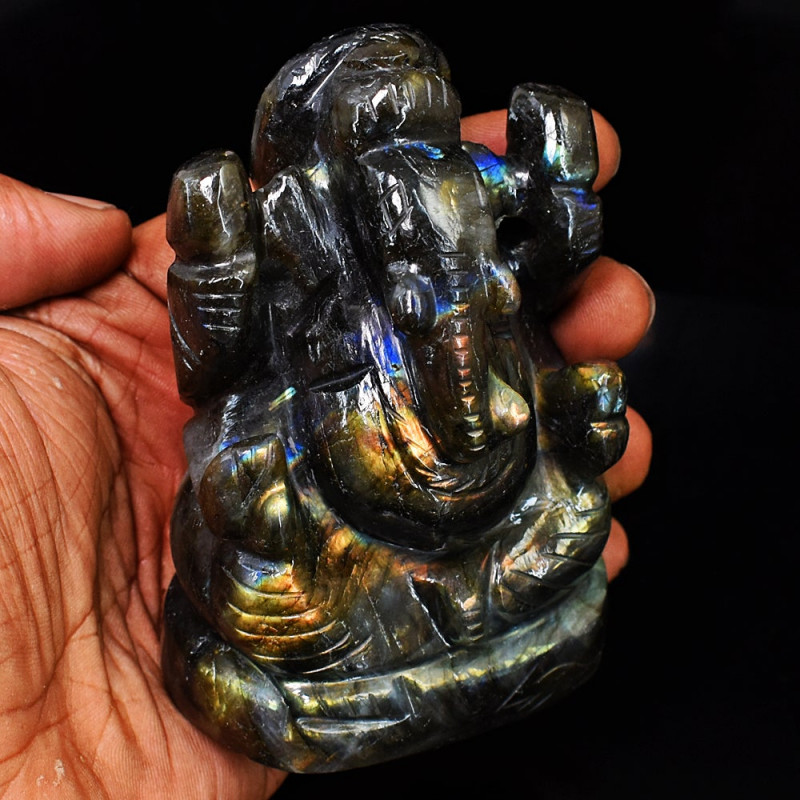
ラブラドライトの意味
ラブラドライトの名前は、1770年に初めて発見されたカナダのラブラドール州に由来しています。ラブラドライトのスピリチュアルな意味から、「魔法の石」や「オーロラの宝石」といった愛称も付けられています。
では、ラブラドライトは何を象徴しているのでしょうか?ラブラドライトは変容、特に変化を経験する際に必要な決意と回復力を象徴しています。スペクトロライトはまた、イギリスにあるとされる古代の星図を記した建造物「星の神殿」を象徴する石とも言われています。
ちなみに、ラブラドライトにはいくつかの伝承があります。イヌイットに伝わるラブラドライトの伝説の一つには、オーロラがラブラドライトの中に閉じ込められ、イヌイットとベオトゥク族に発見されて空に放たれるのを待っていたというものがあります。
フィンランドのスペクトロライトは「光の石」の愛称で呼ばれ、伝説によると直感力、自信、情熱を高めると言われています。フィンランド人の中には、ラブラドライトが北欧神話で神々が住むアースガルズと地球を結ぶ虹の「ビフロスト橋」を象徴していると考える人もいます。
ラブラドライトがスピリチュアルな意味を持つことは分かっていますが、ラブラドライトはスピリチュアルな面でどのような働きをするのでしょうか?ラブラドライトのクリスタルが持つヒーリング効果について見ていきましょう。
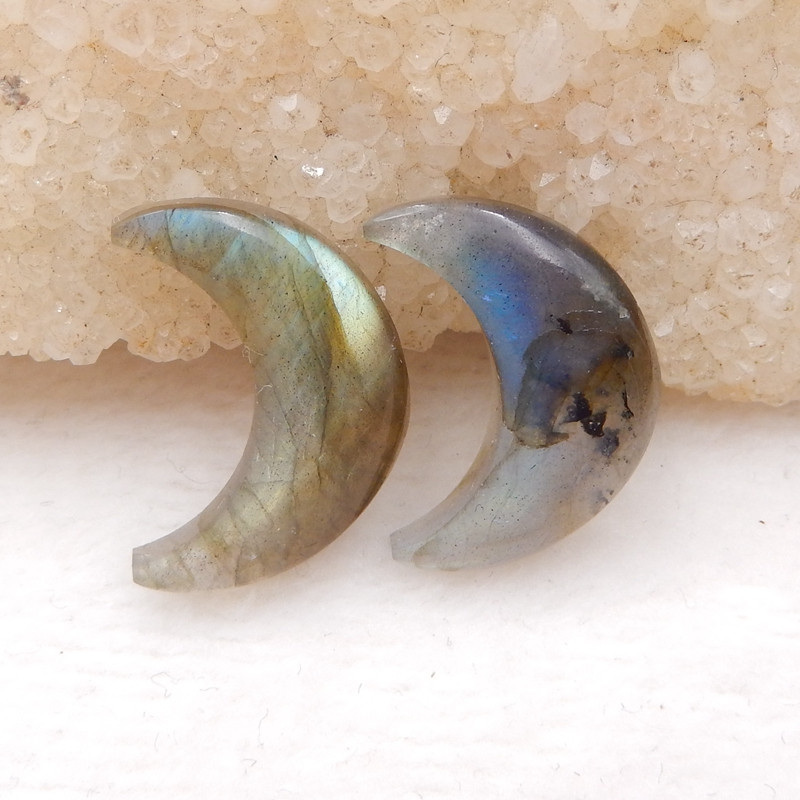
ラブラドライトの治癒特性
すべての宝石には、癒しの力を持つエネルギーがあり、ラブラドライトも例外ではありません!主に青色の輝きを持つラブラドライトは、本来、心を落ち着かせ、悩みを洗い流す力を持っています。
ラブラドライトは、外的・内的両方のネガティブなものを払いのける守護石として、一般的に知られています。自己破壊的な行動を抑制し、夢の実現を助けてくれるという人もいます。
より具体的な治癒のために、ラブラドライト石は何に使用されますか?
身体の治癒
身体的には、ラブラドライトは脳や目の疾患、高血圧の治療に効果があると報告されています。その他にも、冷え性の改善、月経痛の緩和、健康的な消化促進などの効能があるとされています。
感情的な癒し
ラブラドライトの感情的な癒しの効果には、恐怖の軽減、ストレスの緩和、自尊心の向上などがあります。また、ラブラドライトはあなたの最も優れた性格特性を高める効果もあります。
職場におけるラブラドライトの効果は、敵意を軽減し、共感を促進し、より歓迎的で協力的な環境を作り出すことができます。
チャクラヒーリング
ラブラドライトチャクラ ストーンは、第三の目 (眉) チャクラまたは喉のチャクラに最適です。
第三の目チャクラは、より深く、より精神的なレベルで世界を理解する場所です。このチャクラがブロックされていると、受動的になったり、反応的になったりすることがあります。ラブラドライトは、このチャクラを再び開き、洞察力と神聖な叡智との繋がりをもたらしてくれます。
喉のチャクラは、自分自身を理解し、コミュニケーションをとる方法を司ります。不安や臆病さを感じるのは、何かが滞っているサインです。ラブラドライトで喉のチャクラを開くと、自己認識が深まり、コミュニケーションがスムーズになります。
癒しのためにラブラドライトを身に着けるべき理由がわかったので、ラブラドライトのジュエリーを購入する際に何に注意すべきかを検討しましょう。

ラブラドライト宝石の特性
専門家は、宝石の価値を、その価値要因、つまり宝石の特性に基づいて判断します。ラブラドライトの価値要因には、色/虹彩、クラリティ/透明度、カット、そして処理が含まれます。
色彩と虹彩
ラブラドライトのボディカラーは、ミディアムグレーからダークグレー、ブラック、またはブラウンであることが多いです。暗い背景が鮮やかなコントラストを生み出し、虹彩の輝きが際立ちます。
ラブラドライトの最も一般的な虹彩色は青と緑ですが、赤、オレンジ、黄色のものもあります。より稀少で価値の高い虹彩色は、紫、白、ピンク銅色です。
最も価値の高いイリデッセンスは、均一で彩度が高く、色彩範囲が多様なものです。ラブラドレッセンスは、石を動かすと閃光が舞い降りてくるように見える「ブラインド効果」を持つこともあります。
ラブラドライトが虹色に輝く理由は、その含有物にあります。
明確さと透明性
ラブラドライトのクラリティ( 内包物の量と視認性)は、 カラーストーンのクラリティグレードであるタイプIIに該当します。つまり、通常は目に見える内包物が見られます。ラブラドライトの内包物は、微細な不純物の層に光が反射することで、遊色効果を生み出します。
一般的なインクルージョンには、ジルコン、マグネタイト、ルチルタブレット、イルメナイトなどがあります。無色透明なラブラドライトには、暗い色の糸状のインクルージョンがよく見られます。
ラブラドライトのほとんどは半透明から不透明です。興味深いことに、不透明でも透明でもラブラドレッセンスはあまり目立たないため、半透明の標本が最適です。

カット
透明なラブラドライトは、最高の輝きを得るためにファセットカットされ、主にラウンドカットまたはオーバルカットされます。しかし、ラブラドライトはカボション、彫刻、またはビーズとして加工されることが最も多く、ラブラドライトを多く含む斜長岩は、建築用途のために板状にカットされることもあります。
では、ラブラドライトは鮮やかな色の宝石として名声を得ていますが、その色は天然のものでしょうか、それとも加工されたものなのでしょうか?
治療
宝石商はラブラドライトに対して拡散処理と格子拡散処理という 2 つの処理を施すことがあります。
拡散処理は、石を炉で加熱しながら、化学物質を石の表面に浸透させる処理で、通常は1週間ほどかかります。格子拡散処理もほぼ同じですが、化学元素が原子レベルで石に浸透します。どちらの処理でも、より豊かな色や新しい色が得られますが、格子拡散処理の方がより安定しています。
宝石の処理は必ず購入者に開示する必要がありますが、「未処理」の宝石が誤って表示されているのではないかと心配な場合は、 拡散処理の有無を検査することができます。

ラブラドライトの歴史
ラブラドライトは、はるか昔、北米北東部の先住民族であるメイン州のレッドペイント族に知られていました。考古学者たちは、この集団の埋葬地から、西暦1000年以前に遡るラブラドライト製の遺物を発見しました。
ラブラドライトの最初の公式な発見は、1770年にセントポール島でモラヴィア派の宣教師がナイン近郊で発見したことでした。しかし、古代イヌイット族が発見以前からラブラドライトの存在を知っていたという証拠もいくつかあります。
スペクトロライトは1940年に発見されました。フィンランドの地質学者で教授のアーネ・ライタカリは、フィンランドのラブラドライトの「母岩」を探し求めて数十年を費やしましたが、ほとんど成果はありませんでした。第二次世界大戦中、ライタカリの息子ペッカはユラマで要塞を建設していた際に、最初のスペクトロライト鉱床を発見しました。
ペッカはアーネに新たな標本を送り、「母岩」探しが無駄ではなかったことを証明した。宝石商のウォルター・ミッコラは、この石の色彩スペクトルにちなんで「スペクトロライト」という名称をライタカリ教授に提案した。
その後1975年、ニューファンドランド・ラブラドール州当局はラブラドライトを州の公式鉱物に指定しました。1988年には、フィンランド観光局がスペクトロライトを南カレリア地方の州石に指定しました。
なんと豊かな歴史でしょう!でも、発見される前に、ラブラドライトはどうやって形成されたのでしょうか?
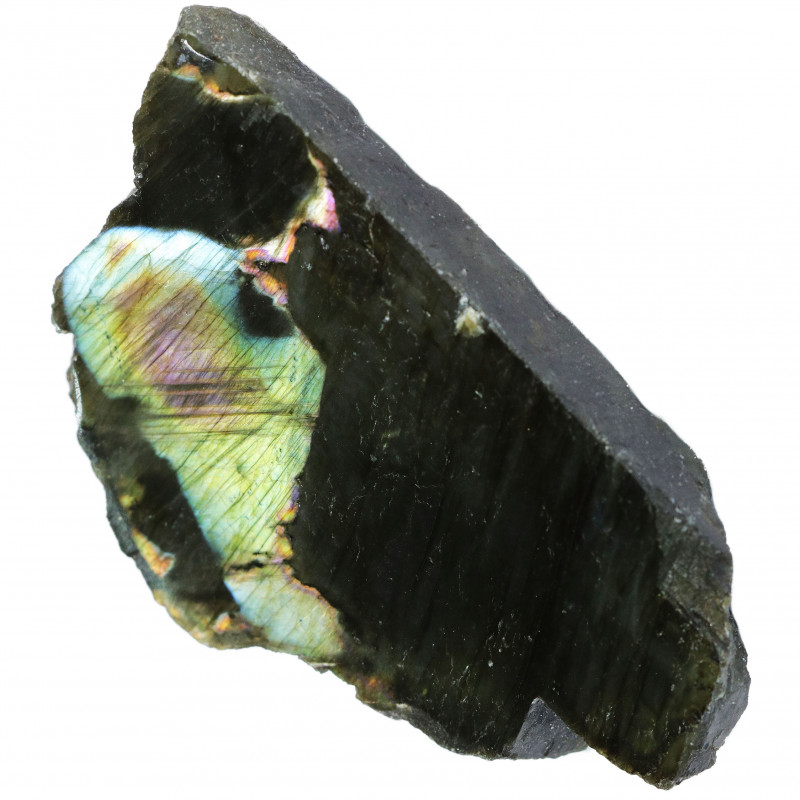
ラブラドライトの起源と産地
ラブラドライトの原石は、火成岩、変成岩、堆積岩の3種類の岩石すべてから形成されます。ラブラドライトは通常、玄武岩、斑れい岩、ノーライト、または斜長岩(ほぼ完全にラブラドライトで構成されている岩石)の中に含まれています。
斜長岩のようなラブラドライトを含む火成岩は、ラブラドライトの別の供給源である片麻岩に変成したり、風化作用を受けてラブラドライトも見つかる堆積物を形成したりすることがあります。
ラブラドライトは結晶構造を持っていますが、完全な結晶を形成することは稀です。鉱山労働者は通常、塊や破片の状態でラブラドライトを見つけます。しかし、ラブラドレッセンスの発現には、石の結晶構造の形成が非常に重要です。
石は薄く密に積み重なった層から形成されます。光が石に当たると、層が光を吸収、拡散、反射し、様々な色で光を照らします。
ラブラドライトは形成された後、どこで見つかるのでしょうか?
採掘場所
現在、ラブラドライトの最も豊富な産地はマダガスカルです。フィンランド、カナダ、アメリカ合衆国にも重要な鉱床があります。希少な透明標本はオレゴン(アメリカ合衆国)とインドから産出されます。
その他のラブラドライト産地は以下のとおりです。
オーストラリア
中国
フランス
ドイツ
グリーンランド
アイスランド
イタリア
日本
ノルウェー
ロシア
スロバキア
スペイン
スリランカ
アメリカ: アリゾナ州、カリフォルニア州、メイン州、ネバダ州、ニューメキシコ州、オレゴン州、ユタ州
イギリス
この石は生産者が多いですが、ラブラドライトは高価ですか?
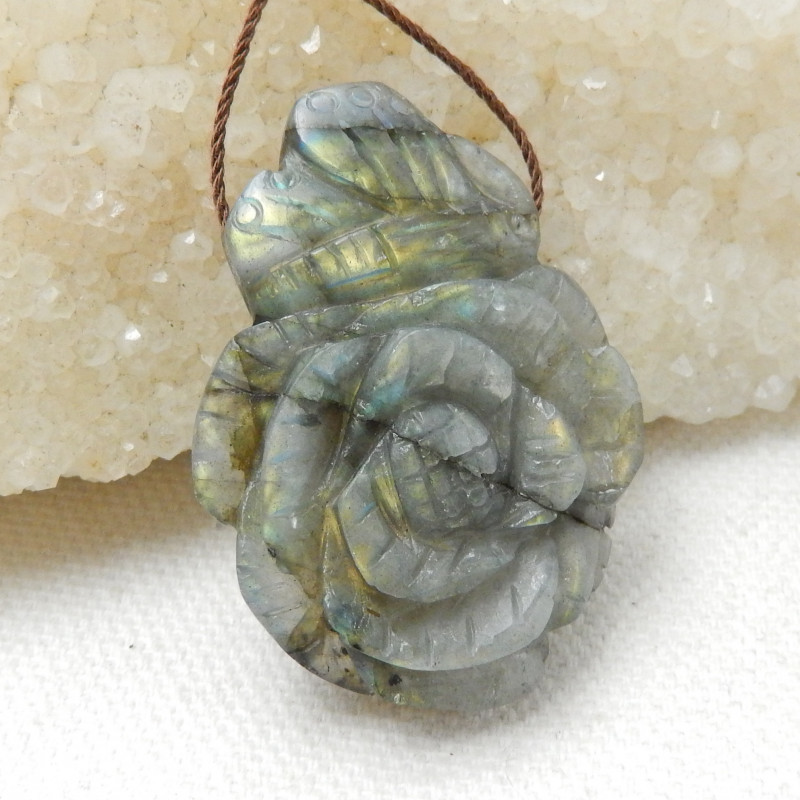
ラブラドライトの価格と価値
ラブラドライトは鉱物としては豊富ですが、採掘されるもののほとんどは宝石品質ではありません。また、ラブラドライトのジュエリーのほとんどは大量生産ではなくオーダーメイドであるため、価格が高くなります。
ラブラドライトの価値を評価する際には、虹色の透明度、鮮やかな色、複数の色、そして暗い背景に注目してください。これらの基準を満たす高品質のラブラドライトは、通常1カラットあたり40ドル以上です。
ラブラドライトのカラット単価は、ブルーラブラドレッセンスを持つ石の方が安く、カボションカットでは1カラットあたり2~5ドルで取引されています。レッドラブラドレッセンスは非常に希少で、1カラットあたり1,000ドル以上で取引されることもあります。
ラブラドライトの偽物を見分ける方法がわからない場合は、回転時の虹彩の輝きを観察してください。あらゆる角度で色の輝きが見られる場合、おそらく偽物です。
ラブラドライトのケアとメンテナンス
ラブラドライトは中程度の硬度と完璧な劈開性を持つため、取り扱いには注意が必要です。ラブラドライトの指輪を強い角度でぶつけると石が割れる恐れがありますので、保護セッティングが施されたジュエリーをお選びください。
ラブラドライトを洗浄するには、中性洗剤、ぬるま湯、柔らかいブラシを使用してください。その後、すすぎ、マイクロファイバークロスで乾かし、他の宝石とは分けて保管してください。
掃除や化粧など、有害な化学物質にさらされる可能性のある作業をする前に、ラブラドライトのジュエリーを外してください。

ラブラドライトで喜びを味わう準備はできていますか?
ラブラドライトの独特の虹彩と豊かな伝承を考えると、ジュエリーデザイナーが精巧な作品に仕上げるのも不思議ではありません。お部屋にラブラドライトの塔を飾ったり、首に ラブラドライトのクリスタルネックレスを巻いたりすれば、人生に自信と前向きな気持ちを吹き込むことができます。
どのように使用しても、ラブラドライトは、雷や困難は虹がすぐそこにあることを意味するだけであることを思い出させてくれる、保護的で励ましてくれる仲間です。
Gemstone Encyclopedia検索
最新記事
レインボーラティスサンストーンは、様々な内包物によって3つのゴージャスな光学的効果を持つ長石の一種です。燃えるように鮮やかな色合いと格子模様が、コレクターにとって希少な宝石となっています。
12th Jan 2026
チューライトは、ゾイサイト鉱物ファミリーに属する、鮮やかなバラ色の色合いを示す希少なノルウェー産の宝石で、ジュエリーのセッティングやペンダントによく使用されます。
6th Jan 2026
ビスムトタンタライトは、タンタライト鉱物群に属する希少な鉱物宝石です。比較的柔らかいため、ジュエリーセッティングには適していません。しかし、コレクターにとっては貴重なアイテムです。
5th Jan 2026
記事のカテゴリ
How To's is where you will find helpful articles from gem Rock Auctions on how to cut gemstones, select gemstones and buy gemstones.
9記事数



